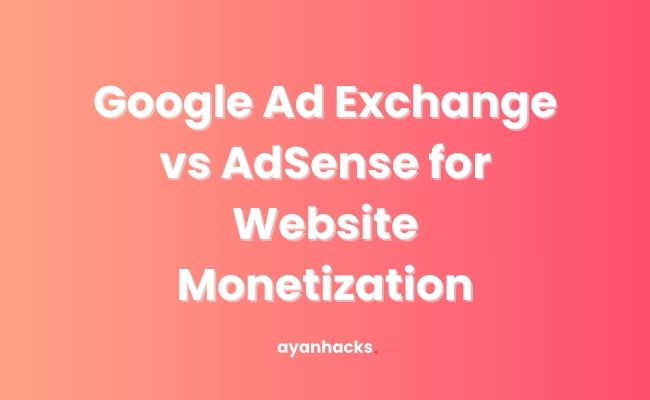Google Ad Exchange, which is referred to as Google AdX, is a formidable competitor. It is a platform that caters to both publishers and advertisers, assisting them in maximizing their online presence and income in the process. This in-depth guide will cover a wide range of topics, including what Google Ad Exchange is, how it operates, the benefits it offers, and how to set up and optimize an account to achieve the highest possible profits.
Google Ad Exchange, sometimes known as Google AdX
The Google Ad Exchange, sometimes known as AdX, is a marketplace that is controlled online by Google. It connects publishers and advertisers from all over the world, making it possible for them to engage in real-time bidding for digital advertising properties. AdX is distinct from other ad networks such as AdSense in that it gives publishers the opportunity to sell ad space to advertisers on a direct basis. This solution is more advanced than others, as it offers a greater variety of tools and services for inventory management and revenue optimization.
- Exploring Revenue Potential: Google Ad Exchange vs AdSense for Website Monetization
- How to Get Adx Approval in 2024
What is the operation of Google AdX?
In the realm of digital advertising spaces, AdX functions as a real-time auction house. A step-by-step explanation of how it operates is as follows:
Compatibility with Publishing Companies
The Google AdX platform is integrated with the digital platforms that publishers use, such as websites and mobile applications. This enables Google AdX to access the advertising inventory that is currently accessible.
Procurement in Real Time
At each and every time a user accesses the platform of a publisher, the available advertising space is put up for auction in real time. These ad slots are bid on by advertisers depending on a variety of parameters, including audience demographics, the format of the advertisement, and the desired placement.
Display and Rendering of adverts
Following that, the winning advertisement is shown on the screen of the user. Through Google AdX, advertisements are delivered in a seamless manner across a wide range of devices and platforms.
Monitoring and Reporting on Performance Progress
In order to assist publishers in making decisions that are informed by data, Google AdX offers them a complete set of analytics tools that allow them to monitor important performance measures such as ad impressions, clicks, and income.
The advantages of utilizing Google AdX
Numerous advantages are available to publishers through the use of Google AdX:
An increased potential for revenue
Because it provides access to a broad pool of advertisers from around the world, AdX encourages better competition, which ultimately results in higher bids and improved revenue for print publishers.
Promotional Management Made Easier
Through the provision of a uniform platform for the management of programmatic advertising, AdX simplifies the entire process for publishers. The ability to define price criteria, manage inventory, and monitor performance are all things that can be done in a single location.
Enhancement of the User Experience
In addition to supporting a wide range of ad formats, AdX also provides demographic targeting, which guarantees that users will receive advertisements that are both relevant and interesting.
Comparing Google AdSense with Google AdX
There are significant distinctions between AdX and AdSense, even though both are advertising platforms that are owned by Google. Because it is considered a premium form of AdSense, AdX is frequently utilized by publishers who are more well-known and established. Furthermore, it gives users access to a wider variety of advertisers and provides them with sophisticated optimization capabilities. AdSense, on the other hand, is more user-friendly and accessible, making it an excellent starting point for publishers with a smaller audience.
Google AdX eligibility requirements
Due to the fact that Google does not make the eligibility requirements publicly available, the process of joining Google AdX is not an easy one. In general, publishers are required to have an account with Google Ad Manager and to conform to the quality requirements that Google has established. In addition to this, they should have a substantial amount of ad inventory available for purchase and a big volume of traffic.
Establishing a Relationship with Google AdX
You can create a Google AdX account directly through Google or a third-party AdX partner. Users have access to both options. Smaller publishers frequently use the latter choice because they either don’t meet the basic requirements or lack the resources to independently manage their account administration.
A connection between Google AdX and Google Ad Manager
Creating a connection between Google AdX and your Google Ad Manager account is necessary in order to get the most of Google AdX. Signing in to your Google Ad Manager account, going to the “Linked Accounts” section, and then following the on-screen directions to link your AdX account are the steps involved in this uncomplicated process.
Boosting revenue through the use of Google AdX
Optimizing your inventory and rules, as well as taking advantage of opportunities and experiments, are all things you should do in order to maximize your revenue using Google AdX. It is also essential to do quality assurance checks and A/B testing on a regular basis in order to guarantee optimal performance.
The CPM Rates for Google AdX
CPM (Cost Per Mille) rates in Google AdX can change depending on a number of factors, including the user’s browser choice, demographics, and technical issues such as the rate at which ads are blocked and how cookies are handled.
Picking a Google AdX Reseller to Work With
For smaller publications, gaining access to Google AdX can be facilitated through the selection of an AdX reseller. When looking for a reseller, it is crucial to find one that provides the appropriate combination of assistance, additional advertising technology, and revenue sharing agreement.






